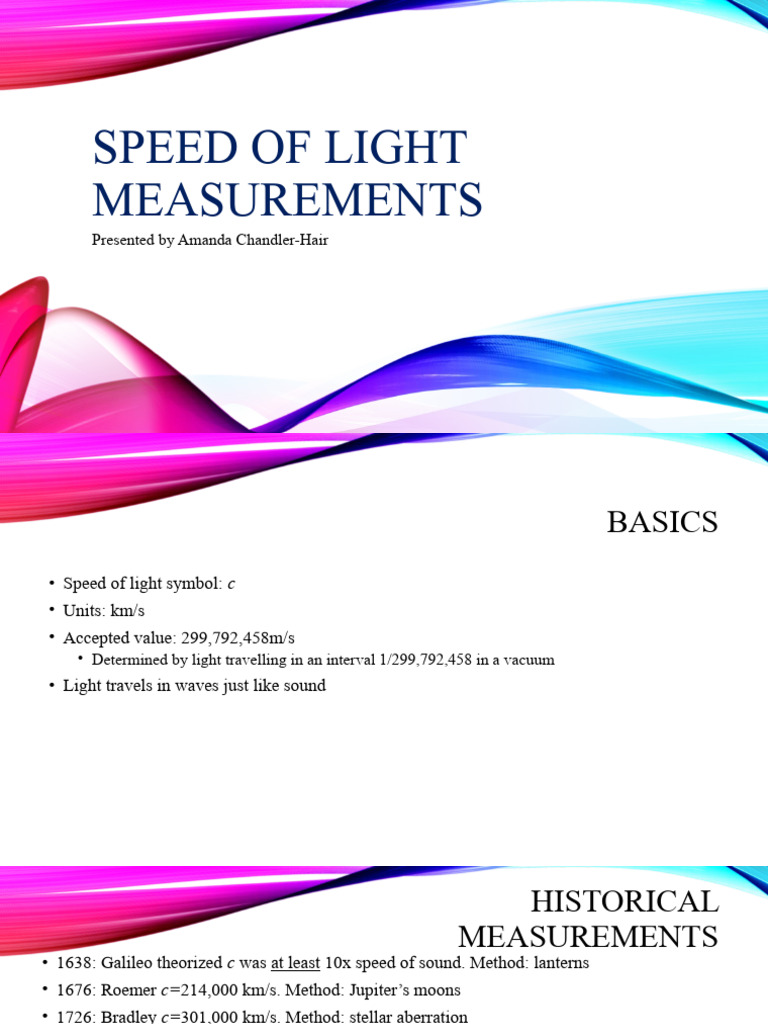The velocity of light, regarded as a fundamental constant in physics, showcases numerous nuances that beg for exploration. At approximately 299,792 kilometers per second (or about 186,282 miles per second), the speed of light stands as a pillar upon which myriad scientific principles arise. However, measuring this elusive speed demands both innovation and precision, particularly when exploring methodologies that surpass mere conjecture. Several instruments historically and contemporaneously have sought to quantify this speed, each with its unique mechanisms and implications.
In the annals of scientific measurement, the earliest attempts to ascertain the speed of light were rooted in philosophical inquiry. Ancient scholars posited various theories, largely mythological, dismissing the concept of light’s finite speed. It was not until the 17th century that experimental methodologies emerged, bringing with them instruments designed explicitly for measurement. Initially, the most renowned approach was the use of a rotating mirror apparatus, a device that spurred a profound shift in the understanding of light.
One of the seminal figures in this realm was Albert A. Michelson, an American physicist who employed a rotating mirror to ascertain the speed of light with unprecedented accuracy. His experimental setup involved a light source that transmitted beams toward a rotating mirror. The reflecting light would then travel an extensive distance before being redirected back to the rotating mirror. The critical variable in Michelson’s experiment hinged upon the rotation speed of the mirror. By adjusting the angular velocity, he could ensure that the returning light beam exited at the exact moment of reflection. This intricate setup allowed for a remarkably refined measurement of the speed of light, contributing significantly to the body of knowledge that exists today.
While the rotating mirror technique represents a pinnacle of historical measurement, contemporary methodologies have expanded the toolkit available to physicists. One notable advancement is the use of time-of-flight measurements. This approach employs astronomical techniques, where devices such as lasers and high-speed detectors are utilized. When light pulses are emitted and subsequently captured by sensors, the time lapse between the emission and detection reveals the speed of light with astonishing precision.
Delving into the complexities of modern instruments, one finds the femtosecond laser, a device that produces optical pulses shorter than a trillionth of a second. This technology enables the measurement of light speed in not only theoretical paradigms but also in substantial real-world applications. Using ultrafast optical techniques, femtosecond lasers have revolutionized how scientists examine light’s properties. An experiment utilizing such a laser can emit a pulse toward a reflective surface, capturing the return trajectory with a high-speed camera, yielding results that are both striking and profound.
Another fascinating tool in the measurement arsenal is the LIDAR (Light Detection and Ranging) system. Initially developed for topographic mapping, LIDAR technology provides invaluable data on the speed of light through its ability to emit laser pulses and measure the time taken for light to return. This technology’s applications have broadened, influencing a diverse array of fields including autonomous vehicle navigation and atmospheric studies. By understanding the time taken for light to bounce back from objects, LIDAR systems can deliver not only measurements of speed but detailed mapping of environments.
Optical cavities also play a pivotal role in the precision of light measurements. These devices operate under the principles of resonance, wherein light oscillates between two mirrors, amplifying the signals captured. Such a configuration enhances measurement accuracy, allowing physicists to discern minute fluctuations in light speed as environmental conditions or materials change. This mirrors the principle of resonance found in music, where precise vibrations yield harmonious results, highlighting the synergy between theoretical physics and practical application.
In the realm of astrophysics, the Cosmological Constant further complicates the understanding of light’s speed. When measuring vast cosmic distances, astronomers are often faced with the challenge of corroborating light speed with the expansion of the universe. Instruments that capture cosmic microwave background radiation and study redshift phenomena offer insights into this complex relationship of light and space, providing a broader context wherein light behaves inconsistently based on gravitational influences and cosmic expansion.
Moreover, the applicability of quantum mechanics introduces yet another layer of depth in light measurement. The advent of quantum optics has led to innovations such as single-photon detectors, which capture individual photons to gauge their speed. This groundbreaking methodology underscores the dual properties of light as both a wave and a particle, thus bridging classical concepts with modern quantum physics.
Thus, the quest to measure the speed of light unfurls a tapestry of scientific inquiry that encompasses historical methodologies, contemporary advancements, and futuristic explorations. Instruments such as rotating mirrors, femtosecond lasers, LIDAR systems, and quantum detectors together bifurcate the traditional paradigms of measuring light. They invite curiosity, inspiring a continuing dialogue about the very nature of light — its properties, its speed, and its implications across multiple domains of science.
The pursuit of discovering the speed of light remains an emblematic endeavor, demonstrating the interplay between innovation and inquiry. Each measurement, whether conducted on Earth or observed from the farthest reaches of the cosmos, deepens humanity’s understanding of the universe. As new instruments are developed and existing technologies refined, the glow of curiosity will undoubtedly illuminate the path forward, enhancing our grasp of the enigmatic nature of light itself.










